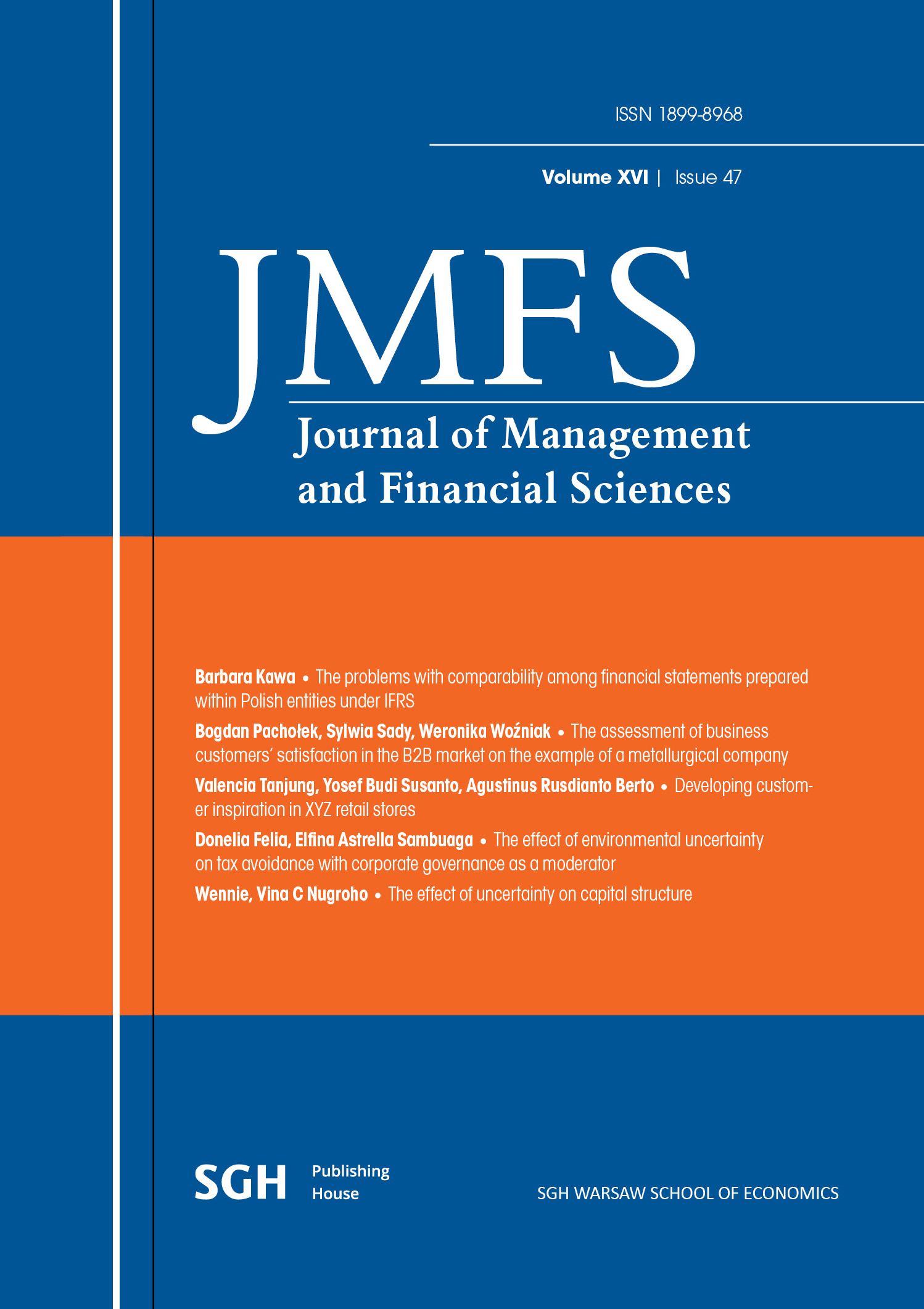The assessment of business customers’ satisfaction in the B2B market on the example of a metallurgical company
Main Article Content
Abstract
The guarantee of a company’s success in the business to business (B2B) market is the acquisition of customers satisfied with the purchased products or services and loyal to the company. The metallurgical industry is a specialised sector with a narrow group of buyers. In order to ensure mutualrelations in the B2B market, numerous activities are carried out to strengthen the ties between business partners. One of such activities is the assessment of customer satisfaction, which gives the company an opportunity to learn about the needs, preferences, and expectations of its customers. The aim of the study was to assess the satisfaction of business customers with the cooperation with a chosen company in the metallurgical industry, a world leader among solutions in the metal heat treatment sector. The CAWI (Computer-Assisted Web Interview) technique was used to achieve the aim of the work, in which proprietary research instruments were used. To assess the loyalty of the company’s business partners, the Net Promoter Score (NPS) was used. The study was carried out at the turn of 2021/2022 in two stages of cooperation between the company and its business partners. The first verification was carried out after signing the final protocol and the second after the end of the warranty period. The study was global. 104 companies from various industries and operating on international markets participated in the survey. The results of the conducted research showed a high rating of customer satisfaction with the cooperation with the company. This is evidenced by both the high values obtained of the NPS index (51.7% for tests made after the device was launched, 55.6% for tests carried out after its warranty period), and high ratings of customer satisfaction with the products and services offered by the company. The results of the study also allowed the authors to identify areas of the company’s activity for further improvement.
Downloads
Article Details
References
2. Dahlgaard, J.J., Kristesen, Kanji, G.J. (2000). Podstawy zarządzania jakością. Warszawa: Wydawnictwo PWN.
3. Doyle, P. (2003) Marketing wartości. Warszawa: Felberg SJA.
4. Athanassopoulos, A., Gounaris, S., & Stathakopoulos, V. (2001). Behavioural responses to customer satisfaction: an empirical study. European Journal of Marketing, 35 (5/6), 687–707. doi:10.1108/03090560110388169
5. García Acebrón, C., Vázquez Casielles, R., Iglesias Argüelles, V. (2010). The effect of perceived value and switching barriers on customer price tolerance in industrial energy markets. J.Bus. Bus. Marketing, 17(4), pp. 317–335. doi:10.1080/10517121003620704
6. Hill, N., Alexander, J. (2003). Pomiar satysfakcji i lojalności klientów. Kraków: Oficyna Ekonomiczna.
7. Jarzyna, K. (2019). Przemysł metalurgiczny na świecie. Retrieved from: https://eszkola.pl/geografia/przemysl-metalurgiczny-na-swiecie-6128.html [accessed: 20.10.2022].
8. Jouve, O., Martin, E., Guerin, M.C. (2012). Case Study: Sentiment-Based Text Analytics to Better Predict Customer Satisfaction and Net Promoter Score Using IBM SPSS Modeler. IBM Corp.
9. Kotler, P., Wong, V., Saunders, J., Armstrong, G. (2004). Principles of Marketing: European Edition. Prentice Hall Europe. Second European Edition. Europe.
10. Krol, M.W., de Boer, D., Delnoij, D.M., Rademakers, J.J. (2014). The net promoter score – An asset to patient experience surveys? Health Expect, 18(6), 3099–3109. doi: 10.1111/hex.12297
11. EMIS Insights (2022). Magazyn przemysłowy. MM. Inwestycje napędzą polski sektor metalurgiczny, ale branżę czekają nowe wyzwania. Wydanie online: https://magazynprzemyslowy.pl/artykuly/inwestycje-napedza-polski-sektor-metalurgiczny-ale-branze-czekaja-nowe-wyzwania [accessed: 20.10.2022].
12. Mandal, P.C. (2014). Net promoter score: a conceptual analysis. International Journal of Management Concepts and Philosophy, 8(4), 209. doi:10.1504/ijmcp.2014.066899
13. Nowotarska-Romaniak, B. (2011). Net Promoter Score w badaniach lojalności klientów firm ubezpieczeniowych. Ekonomiczne Problemy Usług, Zeszyty Naukowe Uniwersytetu Szczecińskiego, 72, pp. 85–93.
14. Reichheld, F. (2003, Dec). One Number You Need to Grow. Harvard Business Review, 81(12).
15. Rudawska, E. (2005). Lojalność klientów. Warszawa: Wydawnictwo PWE.
16. Sahagun, M.A., Vasquez-Parraga, A.Z. (2014). Can fast-food consumers be loyal customers, if so how? Theory, method and findings. Journal of Retailing and Consumer Services, 21(2), 168–174. doi:10.1016/j.jretconser.2013.12.002
17. Schulz, M. (2011). Wpływ satysfakcji na lojalność klientów na rynku B2B. In: G. Rosa, A. Smalec, I. Ostrowska (Eds). Marketing przyszłości. Trendy. Strategie. Instrumenty. Zachowania Konsumentów Trendy i kierunki zmian (pp. 107–116). Szczecin. Wydawnictwo Naukowe Uniwersytetu Szczecińskiego.
18. Spoczyński, M. (2018). Wskaźnik Net Promoter Score a budowanie wartości przedsiębiorstwa. In: Z.A. Nowak, B. Glinka (Eds). Procesy zarządzania w globalizującej się gospodarce. Warszawa: Wydawnictwo Naukowe Wydziału Zarządzania Uniwersytetu Warszawskiego.
19. Staszyńska, K.M. (1998). Customer Satisfaction. Problemy i metody badań. Marketing Serwis, 3, 2.
20. Styś, A.S., Styś, S. (2007). Lojalność w marketingu – postrzeganie, znaczenie, uwarunkowania.
Handel Wewnętrzny, 6, pp. 12–13.
